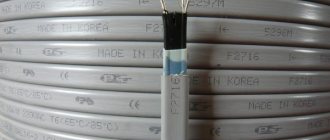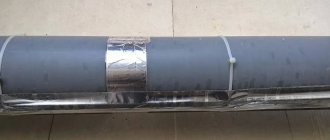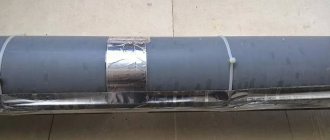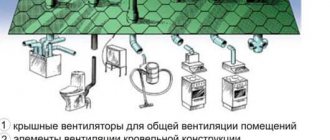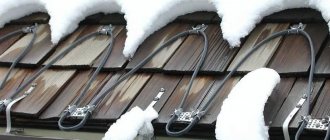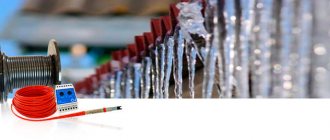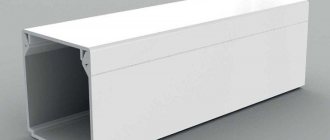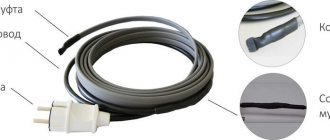Winter cold poses a great danger to water supply systems, especially when it comes to private homes located outside cities and large settlements. Due to poor thermal insulation, pipes may freeze, which will result in a cutoff in water supply. The deeper the pipes are laid, the less susceptible they are to the harmful effects of cold weather. To avoid such situations, it is important to consider a high-quality protection system. The best option is a self-regulating heating cable, which is guaranteed to save pipes from ice jams.
What is a self-regulating wire
Structurally, a self-regulating cable is a flexible wire through which electrical energy flows. This is what causes it to heat up. To prevent the process of increasing temperatures from leading to fire or failure of the cable and nearby objects, the product is able to independently regulate its power depending on the ambient temperature. A simple relationship is observed: the lower the mercury column, the hotter the cable. The surprising thing is that the heating process can occur exclusively in a specific area where it is needed. If any part of the cable is at room temperature, then the power will be lower, and accordingly, the product will not heat up.
If we consider the design of the heating wire globally, we can distinguish three main components:
- conductors made of various metals through which electrical energy flows;
- a “smart” matrix of polymer substances that forces the cable to adapt to the ambient temperature and regulates the process of heat generation;
- an insulating shell consisting of many layers.
The main element that explains the principle of operation of the heating cable is the polymer matrix. Thanks to its presence, the wire exhibits self-regulating properties. The matrix consists of small particles, so its individual elements regulate heating independently of each other. This way, you don’t have to connect various sensors and other electronics to properly regulate the temperature.
Another useful cable option is that you can choose the length you need. Take regular scissors and cut the product where you need it. Connect to the network, as a result it will work without changes. Similar to self-regulation at every centimeter, the cable elements function and work independently of each other. An accidental break will not lead to failure. But such situations are rare, since the cable design is characterized by increased strength.
The main useful properties of a heating cable include:
- Increased resistance to mechanical stress. This is due to the presence of high-quality multilayer insulation.
- Resistant to moisture. It can be used in the water column without any problems. The main condition for this is to perform high-quality insulation using heat-shrinkable tubes.
- Economical. Since the cable independently regulates power, the product never works “just like that.”
The high strength is due to the multilayer structure, with the first two layers consisting of copper conductors and a polymer matrix. Already on top of them is installed insulation made of different materials (for example, fluoropolymers or polyolefin).
After this comes a layer of armor, which is used as copper braiding. Finally, an additional polyolefin layer is placed on top of it all. This design significantly increases the endurance and strength of the product. The copper braid also functions as a shield against electromagnetic radiation.
Design features
The distinctive features of samregs are the following:
- two conductive copper wires have high resistance;
- the semiconductor matrix is located between copper conductors;
- internal insulation of cores and matrix with a uniform structure and maximum thermal conductivity;
- the screen is a metal braid covering the internal insulation;
- The outer heat-conducting shell protects the SNK from mechanical damage and aggressive environments.
Operating principle and scope
The main difference between a self-regulating wire and cables of resistive and zonal operating principles is the design.
The resistive product operates on the principle of a boiler, so it is prohibited to shorten it. In this case, the conductors are the heating elements.
The zone heating wire can be cut into pieces, since its design involves the placement of parallel wires. A heating element consisting of high-resistance wire is placed between the cores. In certain areas, the wire comes into contact with the current-carrying conductor, which ensures heating in a specific section of the circuit.
As for the self-regulating cable, it differs from the previous two in the presence of a polymer matrix. The main elements are hidden under the braiding and protective screens - two current-carrying copper cores and a heating matrix. When examining the latter, you will find ordinary polyethylene. In fact, this device made it possible to create unique and modern heating elements. The matrix is a semiconductor that changes properties depending on the specific air temperature.
Example with heated floors
Self-regulating cables can be used to create heated floors. In the bathroom, the floor temperature will be lower, since heating equipment is usually installed in other rooms. The “degree” is also reduced by the fact that the floor in the bathroom or toilet is usually made of ceramic tiles, which are a “cold” building material. The temperature difference is not limited to this: at one end of the room it can be higher, at the other, which is closer to the windows, lower.
In this case, when using resistive or zone conductors, you will not be able to achieve a comfortable balance. The only way to do this is to divide the rooms into parts depending on the floor temperature under normal conditions, but this is a labor-intensive and painstaking process that involves installing thermostats and heat sensors.
The self-regulating wire eliminates the need to use such elements. You can place it over the entire surface of the floor, while the polymer matrix will take care of itself to create a uniformly heated floor surface. A simple but understandable example: you came home from the street and left your shoes, soaking wet, on a specific area of the floor. The self-regulating cable will detect a cold snap and begin to heat this area more strongly than others. This will happen until your boots warm up to the required temperature. And you will go outside in warm shoes! If there are no boots, then the cable does not heat up as much, which means energy savings occur.
Plumbing example
To prevent water from freezing in extreme cold, a self-regulating cable is used to wind the water valve. The valve is a structure of complex geometric shape, due to which the product cannot be in direct contact with every part of the metal. Zone and resistive wires will heat not only the valve, but also the environment.
If you install a self-regulating cable, the heating process will occur only in places of contact with metal. The principle of operation of the product is based on the efficiency of heat transfer: the more pronounced it is, the more the wire heats up. It is clear that upon contact with cooled metal, the thermal output will be much higher. This leads to an increase in the efficiency of the self-regulating wire compared to other heating analogues.
Example with roof heating
The roof is susceptible to icing in random areas, so it is impossible to determine a specific one. Thus, when using a zonal or resistive heating cable, you will have to lay it over the entire surface of the roof. This will significantly increase energy consumption.
Use a self-regulating cable with a semiconductor matrix, due to which only the area of the roof that freezes and where icicles can form will be heated. Moreover, after it is heated, the cable operates at half power for some time, so the efficiency of its operation is much higher.
Main types of heating cables
There are two main types of heating cable - resistive and self-regulating. Each of them will be discussed below.
Resistive wire
The principle of operation of a resistive cable differs from a self-regulating one. The inner and outer surfaces of the pipeline are wrapped with cable, after which temperature sensors are installed. A thermostat is connected to the circuit, which receives readings from sensors. It is triggered by the slightest temperature fluctuations, however, the action threshold can be set manually. If the air temperature drops, the thermostat is activated, starting the heating of the resistive cable. Electricity begins to flow through the cable, which leads to the release of heat and heat exchange with the water supply. As soon as the pipes are heated to the required temperature, the cable automatically turns off.
Structurally, a resistive cable consists of insulated metal cores. Heating occurs along the entire length of the product, but without temperature control (thermostat), the device can burn out. To increase heating efficiency, water pipes are additionally insulated in order to reduce heat losses and achieve energy costs. Any materials that do not conduct heat can serve as insulation. For example, mineral wool.
Self-regulating wire
The self-regulating cable was developed as an alternative to the resistive version. It has the best technical characteristics and properties. The product can be used for heating water pipes, roofing or forming “warm floor” systems. Structurally, the device consists of two copper conductors located separately from each other, with polymer insulation that can respond to any temperature fluctuations and change resistance. This value increases or decreases in proportion to the ambient temperature, which leads to an increase or decrease in current strength.
The polymer matrix is able to respond to temperature changes at each individual point of the cable. Thus, the temperature will be different in each area. The product is characterized by efficiency and safety due to high-quality and durable insulation. The service life can exceed 20-30 years.
Recommendation. The self-regulating cable can be cut into pieces of arbitrary length and connected separately from each other. This does not in any way affect the performance and efficiency of the product as a whole.
Principle of operation
The principle of operation of a self-regulating conductor is the movement of electricity along the heating cores. As a result, there is an increase in temperature, and therefore resistance.
The higher the resistance, the lower the current and power. Conversely, the lower the temperature, the more heat is released.
Let's look at the operating principle of the cable:
- Self-regulating matrix - a large number of resistances, which are connected in parallel between the heating conductors, heat up when voltage is applied. This leads to expansion of the material, which breaks contacts between conductive particles, thereby reducing the amount of current supplied and heat transfer.
- When the temperature level of the heated area changes, the resistance of the matrix changes and the amount of heat that the heater gives off changes.
What power is required for a heating cable for a water supply system?
The choice of specific power of the product depends on many factors, including the region of residence, the principle of laying the water supply system, the diameter of the pipes used, the presence or absence of insulation and the method of installing the heating element (inside or outside the pipe). Each manufacturer offers detailed product characteristics and tables that describe the dependence of cable consumption per meter of pipe. The table is generated separately for a specific wire model (power).
If there is average insulation of the water supply using 30 mm polystyrene foam shell, in a temperate climate, it is enough to use a cable with a power of 10 W/m to heat each meter of pipe from the inside. For external heating, products with a power of at least 17 W/m are suitable. The closer to the north, the higher the power of the wire.
How to choose the right one
Before purchasing the required amount of conductor, you need to understand what kind of cable is needed. It can be self-regulating or resistive, as well as polyolefin, fluoroplastic or fluoropolymer. It is also equipped with braiding or is available without it. Thanks to the braiding, a product that is stronger and more resistant to various influences is created. Based on temperature, there are cables with low, medium and high temperature heating.
Note! As for the appearance of the power indicator, it depends on the diameter of the pipe. For pipes with a diameter of 25 millimeters, a conductor with a 10-watt power is suitable, and for those with a size of 80 millimeters, a conductor with a 30-watt power is suitable.
Criteria for selecting a heating cable
Laying and connection
Installation of the heating cable can be carried out in two ways - external and internal. In the first case, installation takes place along the pipe (the product can be attached with electrical tape or wrapped around the water supply), in the second, it is laid inside.
Hidden installation inside the pipe
Internal installation is not suitable for all pipes. It is important that the diameter of the water supply is at least 40 mm. With a smaller value, due to its dimensions, the cable will interfere with the free flow of water. It is also difficult to place heating on an overly long route. Therefore, a self-regulating cable is suitable for sections several meters long.
It is much easier to install on vertical sections of pipes, moving from top to bottom. To perform the procedure, use a tee and a sealing sleeve, which prevents the wire from slipping. In some situations, indoor installation is more rational than outdoor installation.
Placing the wire inside and connecting it to an AC source is not difficult. Much more difficult to assemble. Use the instructions with the sequence of actions described below:
- Remove insulation.
- Unravel the braid.
- Remove the corner.
- Prepare the sealing sleeve.
- Frame the coupling using a hair dryer.
- Glue the ends of the coupling together.
- Put on the cap.
- Strip the sealed end.
Open outdoor installation
To perform linear installation of a self-regulating cable along a pipe, less effort will be required. The wire can be fixed to the pipe using plastic clamps that can withstand high temperatures or fiberglass self-adhesive tape. Fastening elements must be installed at a distance of at least 30 cm. The use of metal parts is prohibited. To calculate the length of the wire, you don’t need to be a mathematician: it should be equal to the length of the pipe that you plan to heat.
Brief instructions:
- Secure the cable to the pipe.
- Apply aluminum tape or install clamps.
- Install insulation.
- Fix it on the pipe.
If the pipes are immersed in the ground, then the cable is placed somewhere on the side, and not above or below.
In addition to linear installation, spiral installation can be used. In this case, the cable is wound around the pipeline along its entire length, using a uniform pitch. The advantage of this method is that it ensures maximum contact with the pipe surface, the disadvantage is that the consumption of materials increases. This option is suitable for pipes of medium or large cross-section, which are used in sewer and drainage systems. However, it is often used to heat ordinary water pipes.
Heating of sewer pipes
The need to heat communication pipes, including heating sewer pipes, arises, as a rule, when it is impossible to lay pipes at the required depth, which would prevent them from freezing.
The easiest way to protect utility lines from freezing is to bury them at a sufficient depth. But at the same time, certain areas may still be exposed to cold, and here it is impossible to do without using a heating cable.
In order for any sewer system to function normally and always be in good working order, it is necessary that there is a positive temperature of 5 degrees inside the pipe. Without a sufficient depth of installation, this temperature can be maintained in winter by using a heating cable for the sewer and using it to heat the sewer pipes, thereby heating the sewer as a whole.
Often there is a need to use heating of sewer pipes of a septic tank or local treatment plant. Pipes that are designed to drain wash water from water filters can also be heated.
It is advisable to lay these pipes bypassing the local treatment plant, and the end of the pipe inevitably ends up on the street, which clearly leads to its freezing in winter and the cessation of the functioning of both the sewerage system and the water treatment system.
To secure the sewer heating cable to the pipe, when laying the heating tape, a special reinforced adhesive tape with aluminum coating is used.
The heating cable can be cut into any pieces and, with a length of up to 80 meters, simply connect to an outlet or electrical circuit breaker in the panel.
Use appropriate electrical circuit breakers and residual current devices (RCDs) to power heating cables.
Thermal insulation of heating cables
Regardless of the type of heating wire used, it is important to ensure high-quality insulation. Thermal insulation materials are installed externally, covering the heating elements and the water supply as a whole. If you do not do this, the cable will heat not only the pipes, but also the surrounding air. The thickness of the thermal insulation is selected depending on external factors.
Polystyrene foam and polyethylene foam are considered reliable and long-proven insulation materials. They are characterized by resistance to moisture and provide protective shock absorption for the pipe. On the other hand, it is important to guarantee the protection of the insulation materials themselves, which is why “pipe-in-pipe” designs are often found. A water pipe installed in the ground or outside is wrapped with insulation and then placed in a larger diameter pipe.
Technical specifications
The heating conductor has a reliable and simple structure, a heating element that is resistant to voltage surges, high power conductivity of electrical energy, safe structure and no need for maintenance. It has a relatively high cost per square footage and inconvenient packaging. These are some of the disadvantages of conductors.
It is marked accordingly. D is the conductor marking the low temperature option, Z is the medium temperature option, Q is the maximum heating option, and F is the anti-corrosion treatment. Made from fire-resistant polyethylene and fluoroethylene. It contains copper wire, which is characterized by ductility and flexibility, as well as a maximum operating temperature of 65 to 140 degrees.
You may be interested in this Features of casings for wires
Technical cable specifications
Advantages and disadvantages
Let us highlight the main advantages of a self-regulating cable:
- Possibility to cut into pieces of arbitrary length (usually at least 20 cm). The properties and characteristics of the product will not change. There are no unheated areas on the surface. Similarly, there are no areas with excessively high temperatures.
- During the installation process, wires or segments can be crossed with each other. It is even recommended to do this when heating water pipes. The cable will not overheat and therefore will not fail.
- Even in the event of a break, the wire remains operational. A break in the current-carrying conductor does not lead to failure: up to this point the cable continues to function.
- When heating pipes with this cable, you can use elements located inside. This leads to increased efficiency.
- There is no need to use heat sensors or thermostats. The cable is connected directly to the voltage source or through a switch.
Not without its shortcomings. The main one is the cost of the product. Depending on the modification, with identical power and length, a self-regulating cable can cost two or three times more than a resistive or zonal product.
Another significant disadvantage is that it takes longer to heat a very frozen area. In other cases, its power may simply not be enough. Thus, the self-regulating wire is designed to constantly heat, maintaining the nominal temperature. On the other hand, low energy consumption allows this to be done without significant costs.
The third disadvantage is the high load at startup. Consider a cable with a power of 50 W/m. When such a cable is connected to the network, the load on it will be up to 100 W. This will happen until the cable heats up to the set temperature. This may take from one to five minutes. After this, if the wire is not disconnected from the network, the load does not exceed the specified value.
Manufacturers
Ensto stands out in the domestic electrical products market, offering customers a wide range of self-regulating cables of various lengths and modifications. At the customer's request, the wire can be cut into lengths.
Among the more budget-friendly cable options, which are not inferior in quality to previous products, we can highlight the products of the Devi company.
DIY heating cable: manufacturing instructions
In addition to using factory models, you can make a heating cable yourself. This does not require any special skills or knowledge:
- First you need to come up with an alternative to the product. Many installers recommend using a “field vik”. We are talking about a telephone cable used in military field conditions. The official marking is P274-M. The advantages of the product include small diameter, rigidity, endurance and insulation strength. The latter property allows the product to be used in conditions of high humidity.
- Please note that this cable cannot be compared with store-bought and factory analogues. It will not perform the function of self-regulation, and the isolation will not be food-grade. If you plan to use the wire only occasionally (at the dacha in the winter) and lay it inside pipelines, then you can do without the listed properties.
- When installing the field switch, separate it into separate wires. Bend one conductor in half and twist it in the opposite direction. At the open ends, the cable entry must be sealed. To do this, you can use a hose flange. To improve the tightness, you can take a fitting and thread the wires through it.
- Next, fill the fitting with epoxy glue and flatten it. To strengthen the connection, put on a union nut.
When choosing a self-regulating heating cable, you need to be careful. Study every detail, use the tips outlined above. There is no need to buy an overly powerful product for small areas, since the excess energy will be wasted, and you will not even know what you are paying for. Moreover, the efficiency of the cable will be similar to that of a wire with optimal power.
